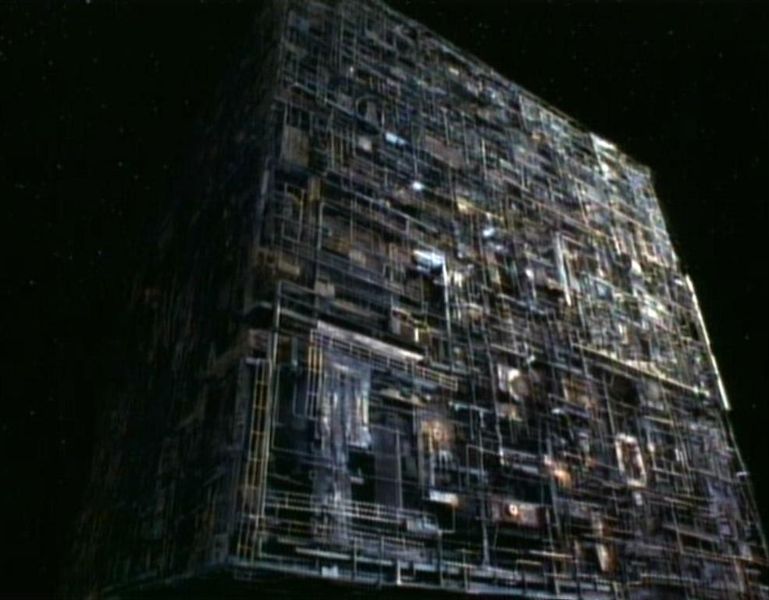Borg Cube: Difference between revisions
Nicesociety (talk | contribs) No edit summary |
Nicesociety (talk | contribs) |
||
| Line 47: | Line 47: | ||
The internal pressure aboard a Borg cube was two kilopascals above what would be normal on a Federation starship. The humidity was on average 92%, and the temperature was at 39.1 °C. (Star Trek: First Contact) The atmosphere contained traces of tetryon particles. (VOY: "Infinite Regress") The infrastructure was made of tritanium, an ore known for its extreme hardness. (VOY: "Endgame") | The internal pressure aboard a Borg cube was two kilopascals above what would be normal on a Federation starship. The humidity was on average 92%, and the temperature was at 39.1 °C. (Star Trek: First Contact) The atmosphere contained traces of tetryon particles. (VOY: "Infinite Regress") The infrastructure was made of tritanium, an ore known for its extreme hardness. (VOY: "Endgame") | ||
[[Category: Borg Collective]] | |||
Revision as of 05:02, 23 November 2008
The Borg cube was the primary vessel of the Borg Collective.
Encounters
The first officially publicized Federation contact with a Borg cube took place in 2365, when the USS Enterprise-D encountered a single cube in System J-25. However, civilian researchers on board the USS Raven had previously tracked a Borg cube a decade earlier in 2353. (TNG: "Q Who"; VOY: "The Raven", "Dark Frontier")
Every Starfleet encounter with a single cube resulted in heavy losses. 39 out of 40 ships were lost at the Battle of Wolf 359 in 2366, and dozens more in the incursion of 2373. (TNG: "The Drumhead"; Star Trek: First Contact) Normally a single Borg cube was capable of eliminating all the elements of civilization from an entire planet.
When the USS Enterprise-D experienced malfunctions due to Wesley Crusher's nanites in 2366, sensors erroneously detected an approaching (nonexistent) cube. (TNG: "Evolution")
Thousands of cubes were estimated to exist in Borg space in the Delta Quadrant; the largest grouping of cubes directly observed by Starfleet was fifteen, by the crew of the USS Voyager in late 2373. (VOY: "Scorpion") When describing the assimilation of his world, Arturis said that hundreds of cubes surrounded his homeworld before its destruction. (VOY: "Hope and Fear")
Technical data
Design
The Borg cube was extremely large in size, measuring 28 cubic kilometers in volume. (TNG: "Q Who") In 2366, Commander Shelby estimated that a cube could remain operative even if 78% was destroyed. (TNG: "The Best of Both Worlds")
Propulsion systems
Borg cubes were capable of both warp and transwarp velocities, in part, thanks to their network of subspace corridors and hubs. When a Borg cube enters a transwarp conduit it projects a structural integrity field ahead of the Cube to compensate for the extreme gravimetric shear. (VOY: "Inside Man") To compensate for the extreme temporal stress while traveling through these corridors, and remain in temporal sync, a chroniton field was also projected through specially designed conduits. (VOY: "Shattered")
Tactical systems
The main tactic employed by Cubes when engaging another vessel was to seize it with a tractor beam and render its defenses useless by draining its shields. Thus, the cube could perform any type of action, ranging from destruction to assimilation, on the defenseless ship. (TNG: "The Best of Both Worlds"; DS9: "Emissary")
Following the failure of enemy shields, the cube usually engaged a cutting beam to slice sections of the ship for assimilation.(TNG: "Q Who"; ENT: "Regeneration")
The cutting beam could also be used as a weapon to destroy vessels showing resistance. During the Battle of Wolf 359, the Excelsior-class USS Melbourne and the Miranda-class USS Saratoga were annihilated by cutting beams, after their shields had been drained by the tractor beam. (DS9: "Emissary")
Another tactic used to disable to vessels fleeing a cube was to fire a type of shield neutralizer. Three shield neutralizer energy bursts were capable of disabling a Galaxy-class's shields.
The cubes could also use dispersal fields to disrupt the sensor and transporter function of enemy vessels. (VOY: "Collective"; TNG: "Q Who")
In addition, a Borg cube's weaponry also included disruptor beams and torpedoes. During the 2366-2367 incursion, a cube obliterated three ships of the Mars Defense Perimeter with torpedoes. The concentrated fire of three Borg disruptor beams was able to reduce USS Voyager's ablative hull armor integrity, a highly advanced future Starfleet defense technology, to 40%. (VOY: "Endgame")
Support vehicles
Ships up to the size of a Borg sphere were able to be docked inside a Borg cube for assimilation, supplies or escape purposes.
At least one Borg cube, and possibly others of its class, contained a Borg sphere. The only known recorded purpose of a sphere disengaged from a Borg cube was for escape. The sphere is the only documented support vehicle a Borg cube possessed. (Star Trek: First Contact)
Interior design
Borg cubes were typically manned by "thousands of drones," and could vary in capacity anywhere from 5,000 to 64,000 to 129,000 drones. (VOY: "Collective", "Unimatrix Zero", "Dark Frontier")
Borg cubes were highly decentralized in structure. No specific bridge, living quarters or engineering section was observed. All vital systems were spread throughout the ship, which, along with the presence of a regenerative outer hull, made it highly resistant to damage and system failures. (TNG: "Q Who")
Information and Collective communication were routed through power waveguide conduits and distribution nodes. Its exterior design consisted of perpendicular and diagonal grids, struts, and weaponry, allowing a characteristic green light to emanate from within. (TNG: "Q Who", "The Best of Both Worlds", "The Best of Both Worlds, Part II")
Some vessels are equipped with Borg nurseries. (TNG: "Q Who"; VOY: "Collective")
The internal pressure aboard a Borg cube was two kilopascals above what would be normal on a Federation starship. The humidity was on average 92%, and the temperature was at 39.1 °C. (Star Trek: First Contact) The atmosphere contained traces of tetryon particles. (VOY: "Infinite Regress") The infrastructure was made of tritanium, an ore known for its extreme hardness. (VOY: "Endgame")
